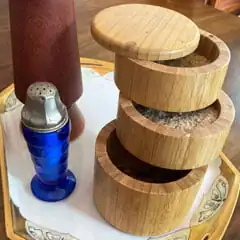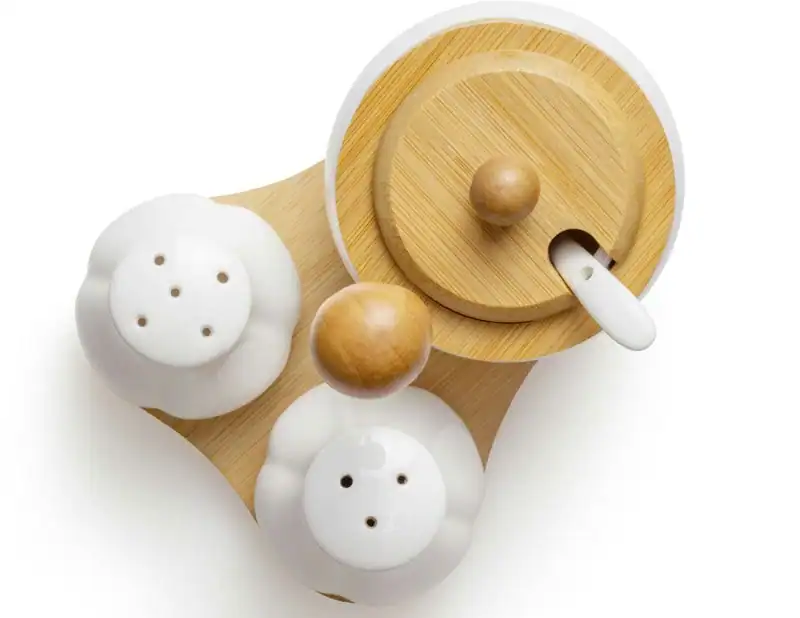One of the things I’ve learned about Culinary salt is that you tend to use the salt that is at hand. It is key to have the right salt storage or salt dispensers in the right places in your kitchen and dining areas. Selecting a Salt cellar, salt grinder, and even a salt “pig” might work better at keeping your salt at hand than a salt shaker.
This article explores how to pair your favorite salt with the best salt storage so that you can get the most enjoyment from your salt selection!
Salt Storage Considerations
Why choose salt cellars over a shaker or a grinder, for example? Different salt calls for different containers. Here are some things to consider when selecting how to store your salt:
- Texture – Flaky Sea Salt often is best in a container where it can be pinched or spooned. Finely ground salt like table salt or popcorn salt benefits from a dispenser with holes of the right size to match the grain size, allowing you to control how much salt is dispensed when you shake or pour.
- Grain Size – Many culinary salts just don’t work in a salt shaker. The larger grain size calls for a salt container with a top that opens easily.
- Application – When applying salt to the top of food as a finishing salt, you often want a much smaller grain size – a perfect application for a salt grinder.
- Moisture – Salt is a natural desiccant – it has the property of absorbing and releasing moisture. To avoid clumping, sometimes you want to protect your salt from the air. There are also salts like Celtic Sel Gris that are produced so that they intentionally retain some moisture – so they don’t well with grinders or shakers.
- Food Grade Material – When storing food, choose a material that can stand up to the corrosive properties of salt and maintain it in a food grade state. Ceramic, glass, porcelain, marble, woods like Acacia or Bamboo are all good choices.
Types of Salt Storage
Humans have come up with a variety of ways to store and dispense salt over history. Let’s look at some of those choices for salt keepers.
Salt Shaker
Salt shakers still tend to be one of the most common methods of dispensing common table salt – whether it be in homes or in restaurants. The holes in the dispenser have tended to get a little bigger over the years.

I have some vintage shakers that have VERY small holes. Maybe hole size over time corresponds with salt consumption in our diets?
Salt shakers tend not to work very well for anything but table salt. Kosher salt, flakey sea salt, and other salt with texture or larger grain size needs a different approach. I do keep a larger shaker with an adjustable top in the cupboard next to the stove. I use it as a handy way to add table salt to pasta water, or to add a bit of salt to recipes that call for generic salt.
Salt Cellar
Where I grew up, a cellar was usually a dark, moist, spider infested space under an old house or other earthen space. They are not spots where I would consider storing salt! So how did we get the name ‘salt cellar’?
It turns out that this term comes from what was called a ‘salt salar’ where salar was a Middle English name for ‘salt container’. This term probably came from the Middle French word ‘salier’ which meant the same thing. Dictionary entries also indicate that ‘saltcellar’ and ‘salt-cellar’ are also accepted spellings for salt cellar.
These days, items sold as Salt Cellars tend to be a small container with a lid that opens easily, and some of them come with small spoons or paddles built in. They don’t tend to be air-tight, but they are made from material that is resistant to corrosion from the salt.
Salt Grinder
Grinders used to be seen mostly with seasonings like pepper. Those grinding mechanisms were made from metal which tended to corrode with long exposure to salt. Once they came out with affordable ceramic grinding mechanisms, grinders became one of my favorite methods of storing and dispensing salt.

The clear glass base of this grinder allows me to see which salt I’m using – in this case a very coarse grained Pink Himalayan salt. The top contains a ceramic grinding mechanism and a clear plastic lid (not shown in the picture) keeps dust and moisture out of the top of the salt grinder.
Salt Pig
Here’s another odd name and it has nothing to do with pork (although salt is certainly used to preserve meat like ham)! ‘Pig’ is a name for ‘pot’ in Scotland, so a salt pig is a jar-like container for salt where you can reach in for a pinch of salt or use a spoon to scoop some out. They differ from a salt cellar because the opening on the container is usually on the side and it often does not have a cover. This makes it easy to reach in for a pinch.
Salt pigs tend to sit on the counter near the stove or meal preparation area. Sometimes they also get called ‘pinch pots’.
Salt Tins
A ‘tin’ used to mean a metal container that was made from tin. Modern tins are now available in Aluminum, which will better hold up to salt. I like my salt tins when I store a variety of salts in a kitchen cupboard. They are stackable, and have close-fitting lids to keep the air out, yet the tops come off easily when I want to pinch or spoon out a portion.
Tins can be nice when you have a variety of seasoned salt – such as salt mixed with herbs like Rosemary, or salt mixed with ingredients like chile flakes or garlic. The close-fitting lids keep the flavors fresher and from mixing with flavors from nearby containers. I also have a set of Salt Tins that have a magnet on the bottom and a clear window in the center of the lid. These are handy for storing your salt selection when you have a small kitchen – just stick them onto the side of the refrigerator!
Best Salt Storage
After trying a number of ways to store, organanize (and find) my different types of salt, here are my picks for storing and dispensing salt. Some of these are pairings: the best salt keeper paired with a certain type of salt.
Salt Selection on the Dinner Table
I like to have several choices of salt at hand when serving dinner. In order to not have to set them out, or having to get up during dinner, I found this multi-tier salt cellar.
It is made from Bamboo and has tiny magnets embedded in the lid and each tier. The magnets align the lid and each tier into a column. There is a post built into the stack, which allows each tier to swivel open.

Pairing: I keep Maldon salt for finishing, a salt mixed with Italian herbs (Rosemary, Thyme, Oregano), and a spicy salt mixed with Aleppo pepper flakes in my multi-tier salt cellar column. Table salt is available in the cobalt blue glass shaker, and the wooden grinder shown in the picture above contains Malabar peppercorns.
This ingenious multi-tier salt cellar is made from Bamboo. The levels pivot from a column on one side and have small embedded magnets to line up the three tiers when the tiers are aligned. They've also supplied a tiny bamboo spoon that fits into the lid.
Best Salt Grinder
My favorite grinders have ceramic mechanisms that are terrific for use with salt. The glass base is large enough that it fits well in your hand while grinding and holds a goodly amount of salt. These are designed to be refilled – and both the base and the ceramic grinder are washable.
Pairing: Grinders work great with Pink Himalayan Salt which often has a grain size that is medium to larger sized. They are nice for salt seasoning mixes that feature coarse sea salt blended with dry herbs such as Rosemary or Oregano. I also like to keep my Kosher salt in a ceramic grinder because the salt grain size is larger than what I want to use – a grinder allows you to easily adjust the grain size coming out.
I’ve made up a story in my head that there is one gigantic factory in China where all they make is these ceramic grinders. They put different materials around the top and sometimes engrave a brand name on them for some other company, but then distribute them to all the various companies that sell them globally. While this is probably just a case of really exact knock-offs, all of my grinders work equally well and look like they came from the same place, no matter if I bought them online, bought them already filled with salt and peppercorns, or if I find one at the thrift shop. The parts are interchangeable. From the looks of the reviews, about 3% of the time they don’t last a full year, but I have never had that happen to me. For me, these seem inexpensive for how well they work and I can’t see the point of paying more for a grinder that is probably about the same.
This is a package of two ceramic grinders (salt and pepper not included). The grinder portion has a Stainless Steel appearance and comes with a lid. The jar portion is clear glass. The package also comes with a small funnel.
I am not currently able to find the ceramic grinders with the black plastic tops. I actually prefer them over “Stainless Steel” because the black hides oily fingerprints better than shiny metal does. I’ll update the link if I locate the black top grinders.
Best Salt Cellar
Salt cellars are great for keeping salt that needs to be pinched or scooped quickly at hand. They work best with salts that don’t tend to solidify or clump up, because most salt cellars have a loosely fitting lid, so that you can easily lift it off and pinch.
Pairing: Celtic Gray Salt – even though this salt is fairly dry to the touch, if you put it in a ceramic grinder, it’s moist enough that it will tend to ‘gum up’ the grinder mechanism. It also doesn’t come out of the top of the grinder in a smooth pattern – the clumps just drop out at random.
Pairing: Maldon Sea Salt Flakes – my ultimate salt for pinching and rubbing between my fingers to spread it on food works perfectly in a salt cellar. Keep this container in a breakfast nook so that you can easily season your eggs & hash browns.
This salt cellar or 'box' holds up to 3/4 cup of salt. There are a few different fonts available for the lid engraving, and also a version that comes with a spoon. The lid easily swivels open, but when in the closed position, a tiny embedded magnet keeps the lid in the right place.
Best Cupboard Storage for Salt
For salt that I don’t have room for on the counter near the stove, or in my multi-tier container on my dining room table, I like to keep it near at hand in the cupboard near the stove. For this purpose, I like to use Aluminum tins with close fitting lids. I can put a label on the side of the tins, and they stack nicely, so I can see at a glance with salt I want. The stack also doesn’t take up much room in my cupboard.
Pairing: Hawaiian Sea Salt – I keep both Hawaiian white sea salt and Alaea Red Salt on hand. When I’ve prepared Edamame and drizzled it with sesame oil, my Alaea Red is nearby in the same cupboard as my Aleppo pepper flakes. Note that these tins are great for storing spices as well.
These tins hold up to about 6 ounces (approximately 3/4 cup) of salt or other seasonings. You get 12 aluminum tins with screw on lids in this package. The tins are 3.2 inches in diameter and 1.57 inches tall.
Best Salt Storage for Compact Kitchens
No counter space left? No room in your cupboards? What’s a foodie with a “salt habit” to do? My recommendation is to get some aluminum Salt Tins with a magnet on the bottom of the tin. The tops of these tins are also thoughtfully supplied with a slots to shake or pour out the contents by simply twisting the lid. The tops are clear, so you can see what salts (or seasonings) you’ve got on hand and if anything is getting low.
These will magnetically attach to any ferrous surface. Note that some Stainless Steel appliance surfaces may not work with a magnet. One of the product options with these tins is to also buy a mounting plate. Mounting plates can be stuck on a wall or inside a cupboard door with 3M Command Strips.
This package of 12 aluminum tins comes with lids that you simply turn to the right position to shake or pour out the contents: no need to take the lid off! On the bottom of each tin there is a magnet. The lids have a clear insert so that you can see what's inside. Each tin is about 2.5 inches in diameter and is 1.8 inches tall - holding about 3 ounces.
Pantry Salt Storage
Original packages are often fine for storing salt for long periods of time, but for dispensing, have salt on hand near where it is used: dining room table, breakfast nook, near the stove or cutting board – wherever you do food preparation. Mylar or plastic bags with a zip top are okay for sitting in a dry cool cupboard, but are a pain to get open when your fingers are wet or oily. I fill up a salt cellar, tin or grinder, then store any excess salt in my cool, dark & dry pantry. It usually is in good condition when I am ready to refill a salt container.
By the way, I often get asked about whether salt expires. This is not really the case – after all, much of the salt we eat has been in the form of salt for tens of thousands of years or more. Food manufacturers are required to provide an expiration date on packaging even though salt itself does not “go bad”.
However, salt that is not stored well can clump or solidify, absorb aromas from other things in the pantry, or can pickup a ‘plastic-y’ flavor if stored in plastic containers for a long period of time. If the salt is mixed with other seasonings, such as herbs or chile flakes, the things that are mixed in will lose their flavor over time. I go into more depth with salt expiration as related to Himalayan salt in The Truth About Himalayan Salt Expiration: What You Need to Know.
Dealing with Moist Environments for Salt Storage
Salt is a natural desiccant, which means it wants to absorb moisture from the air. Even in Colorado, certain kinds of salt want to clump up a bit during damp months. If you find that some of your salt is clumping, try adding a packet of desiccant in the bottom of the salt cellar or tin to absorb any excess moisture.

This desiccant packet has kept my Maldon salt in great shape for months.
You can also use a small desiccant packet in the bottom of a ceramic grinder, but be careful not to let itself work it’s way to the top! You don’t want to grind up the edge of the packet ;)
I often reuse desiccant packets that come with other food or vitamin packaging, but if you don’t have any of these available, they are available here:
Small Silica Gel packets are perfect for helping to keep the moisture out of your salt. They contain 5 grams each and are small enough that they should fit in your salt storage containers: 2.3" x 1.7".
If you reached this article looking for tips on storing salt outside – such as pool salt, water softener salt or deicing salt, head over to this article: Don’t Make These Mistakes When Storing Pool Salt Outside.
Old-Fashioned Salt Moisture Cure
Before we had desiccant packets, we used rice as a natural moisture control remedy for salt shakers. Simply replace about 10% of the volume in your salt shaker with whatever rice you have on hand. Traditionally we used white rice, but any rice will do: Brown, Basmati, Sushi, Arborio, etc. I would not use the rice method in a grinder. Ground rice wouldn’t hurt you of course, and you might not even taste it, but it might gum up your grinder.
Salty Gift Ideas
Many of the salt storage and use gear on this page is on the utilitarian side of things – and is what I use in my own kitchen. If you came to this page looking for some more elegant salt related gear that is perfect for gifting, you may want to check out A Gift of Salt: Gift Ideas for People Who Have Everything.
Recycling Salt Packaging
Once you’ve moved your salt to a nice salt cellar, tin or grinder, what do you do with the empty product package? Some of them don’t look obviously recyclable, and some are made from more than one material. I’ve written an entire article about that subject with some quick tips on how to tell what to do with an empty salt container.
Table of Contents
Feature photo by Mockup Graphics.













